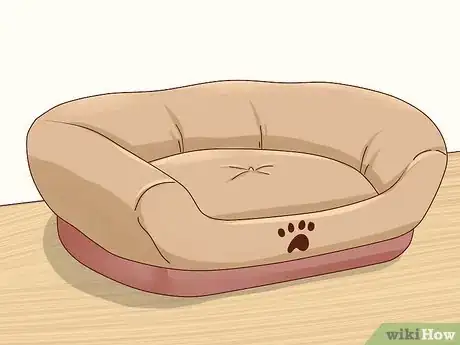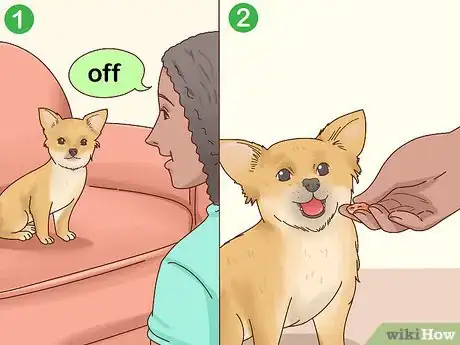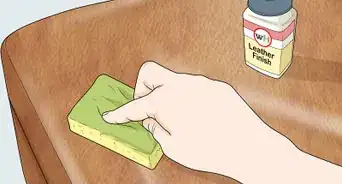This article was co-authored by Dominik Feichtner. Dominik Feichtner is a Professional Dog Trainer and Behaviorist and the Owner of The Dog Behaviorist NYC out of New York, New York. With over eight years of experience working with dogs, Dominik specializes in general obedience, behavior modification, and puppy training. His commitment to a balanced, common-sense approach led to his recognition as one of the “Best Dog Trainers in Brooklyn” and one of the “Best Dog Trainers in NYC” by Pooch and Harmony in 2020.
There are 9 references cited in this article, which can be found at the bottom of the page.
wikiHow marks an article as reader-approved once it receives enough positive feedback. In this case, 90% of readers who voted found the article helpful, earning it our reader-approved status.
This article has been viewed 600,585 times.
Pets are wonderful companions that can make any place feel like home. Sometimes, however, pets can become territorial over pieces of furniture, or leave shed fur all over your clean couch or bed. When these inconveniences arise, it's important to teach your pet to stay off the furniture. Learning how to break these bad habits can help you train your pets to stay off the furniture for good.
Steps
Providing Alternatives
-
1Get your pet a comfy bed. Before you can train your dog or cat out of sleeping on the couch or bed, you'll need to give your pet a comfortable alternative. You probably won't have much luck keeping your pet off the furniture if you don't provide some kind of alternative.[1] In fact, some pets are better off sleeping on soft furniture, due to arthritic pain or discomfort sleeping on the floor.[2] A dog or cat bed can help provide your pet with a comfortable place to sleep without causing you any inconvenience.
-
2Get your cat a condo. If your cat continually climbs on furniture and it's causing you problems, one of the best alternatives you can provide your cat is a cat room. Cat condos are multi-level structures that allow cats to climb, jump, and sleep in one of the "rooms" or on one of the platforms. These indoor structures allow your cat their own place to sleep while also allowing them to climb and get exercise.[3]Advertisement
-
3Designate one piece of furniture for pets. If your pet isn't satisfied with sleeping in a dog or cat bed, consider designating one piece of furniture as a pet-friendly spot. It could be an old arm chair or a love seat that you don't really use anymore - anything that your pet will take a liking to. However, it's important to reinforce to your pet that he can't climb on other pieces of furniture.
- Some animals may have a hard time understanding, especially at first, why one piece of furniture is okay but others aren't. The key is consistency. Any time your pet tries to climb up onto a "humans only" piece of furniture, lead him off that furniture and onto his designated chair.
-
4Use treats as an incentive. Once you provide your pet with an alternative, "pet-friendly" piece of furniture, you may need to train your pet to use that piece of furniture instead of humans-only furniture. Treats can be very effective for this. Leave treats on the dog/cat bed, in the cat condo, or on the pet-friendly piece of furniture to make these pieces of furniture highly desirable to your pet.[4] Any time your pet tries to get on a humans-only piece of furniture, make them get down, and toss a treat onto the piece of furniture or bedding you've provided for them.
-
5Crate or confine your pet at night. If your dog or cat keeps trying to climb into your bed at night, you may want to consider crating or confining your pet to another room when you go to sleep. Even simply closing your door and keeping them out of your room may be effective, provided that you give your pet a comfy bed or blanket to sleep on in the crate or room you confine them to.
-
6Restrict your pet's access from the start. If you've recently brought home a new pet, or you plan to in the near future, it's best to restrict your pet's access to furniture from day one, if being on the furniture is an issue for you. It will be much harder (though not impossible) to break this habit once your pet has learned that it's acceptable to be on the couch/chair/bed, so curbing this behavior from an early age is crucial.
Making Furniture Less Desirable
-
1Keep food away from the furniture. It's possible that your dog climbs on the couch because they know you snack there, and there might be crumbs in the cushions. Or maybe your cat climbs on the kitchen counter because they know you put their food bowl up there from time to time. Whatever piece of furniture your pet is climbing on, there's a chance they've come to associate that location with food. Keep food away from the furniture you're trying to train your pet away from, and promptly clean up any messes you make on or near that furniture.[5]
-
2Use double-sided tape. One way to train your pet out of using furniture (and keeping your pet off, even when you're not home) is by making the furniture less comfortable. Buy some cheap place mats and cover one side of them with double-sided scotch tape. You can then lay these sticky mats, with the adhesive side up, on whatever counters or couch cushions your pet is drawn to, or just apply double-sided tape directly to the furniture. The sticky sensation will be extremely uncomfortable, yet it won't harm your pet, and if you're using place mats it won't damage your furniture, either.[6]
-
3Use aluminum foil. Aluminum foil is another simple furniture deterrent that will make furniture loud and uncomfortable, and therefore undesirable, without harming your pet or damaging your furniture. Simply lay sheets of aluminum foil across couches, chairs, and counter tops. You can also use an upside down plastic carpet runner across your couch and chair cushions.
-
4Block access to furniture. A simple way to keep pets off your couches and recliners is by laying other furniture, like folding chairs, across the cushions. This will remove all temptation by making the furniture completely inaccessible to your pet, yet it's still simple enough for you to easily remove when you want to sit on the couch or chair.[7]
-
5Create a gentle booby trap. One way to train your pet out of climbing onto furniture, especially when you're not home, is to lay a gentle trap. A good example of a harmless (yet effective) booby trap is to stack a bunch of empty soda cans on the furniture. Be sure the empty cans are well-rinsed, to ensure that no sticky residue gets on your furniture. You can build a little pyramid, either on a couch cushion or on the headrest above an armchair, and if your pet tries to climb up the toppling cans will frighten him off the furniture. Over time it may startle him enough to stay off the furniture permanently.[8]
-
6Buy a deterrent device. If you don't want to create your own furniture blockers, there are a number of commercially-available furniture deterrent devices on the market. The Snappy Trainer consists of a large paddle attached to a sensitive trigger, which can detect when an animal has climbed onto the couch or chair cushion and causes the whole device to snap up in the air. The SSSCAT, another motion-activated device, shoots a blast of air at your pet if they cross the motion sensor while climbing onto your furniture. The Sofa Saver is a device you lay across the couch, and if your pet climbs onto it, the device activates a noisy alarm that will scare away your pet. Each of these devices can prove to be highly effective because they startle your pet without causing any harm, and they can be used even when you're not home.[9]
Teaching the Off Command
-
1Observe your pet on the couch. The off command, though highly effective, does require you to be present and observe your pet climbing onto off-limits furniture. This technique works better for dogs, since dogs tend to respond to verbal commands better than cats. When you observe your dog climbing onto a couch or chair they're not supposed to be on, rather than physically removing them (which may elicit an aggressive reaction from him), teach your pet the "off" command.[10]
-
2Say "Off" and give a treat. As soon as you observe your dog on the couch or chair, use a calm-yet-stern voice to say, "Off." Then hold a small treat in front of their face, and pull the treat (with your dog's nose in tow) slowly away from the couch or chair and down to the floor.[11]
-
3Praise your dog, and repeat. As soon as your dog gets down from the furniture, offer them verbal praise and give them the treat you led them away with. Start out giving your pet treats every time they climb down, then gradually taper off how frequently you give treats with the "off" command. Eventually you should be able to command your dog to get off the furniture simply by saying, "Off."[12]
Finding Alternative Strategies
-
1Give your pet more exercise. One possible reason your cat may be climbing on furniture is because they aren't getting enough exercise and stimulation on a daily basis. If you cannot provide them with a cat condo, get your cat a scratching post, and use interactive toys that allow your cat to chase, run, and jump. This should tire them out, removing some of the necessity to climb, scratch, and explore your furniture.[13]
-
2Use chemical deterrents. Cats and dogs have a natural aversion to anything that smells or tastes like citrus or bitter apple.[14] You can use this to your advantage as you train your pet to stay off counters or furniture. Use citrus-scented cleaning products on the counters you want to keep a cat off of, or spray a little citrus-scented oil or bitter apple on couches to keep pets off. (Just be sure that you don't ruin your furniture by spraying oil extracts on the cushions!) Dogs and cats are both repelled by these scents, and will stay away if you make certain environmental elements smell like these undesirable scents.[15]
-
3Crate or confine your pet. If your pet tends to climb on furniture when you're not home (evidenced by lots of hair or scratch marks on furniture), consider getting a crate for your dog when you're not home, or confining your pet(s) to a designated area, like a bathroom or kitchen.[16] You can also use baby gates to block access to certain rooms or pieces of furniture.[17] Just be sure your animals have access to food and fresh, clean water, and aren't exposed to uncomfortable temperatures, no matter where you confine them.
Expert Q&A
-
QuestionIs it possible to keep dogs off furniture?
 Dominik FeichtnerDominik Feichtner is a Professional Dog Trainer and Behaviorist and the Owner of The Dog Behaviorist NYC out of New York, New York. With over eight years of experience working with dogs, Dominik specializes in general obedience, behavior modification, and puppy training. His commitment to a balanced, common-sense approach led to his recognition as one of the “Best Dog Trainers in Brooklyn” and one of the “Best Dog Trainers in NYC” by Pooch and Harmony in 2020.
Dominik FeichtnerDominik Feichtner is a Professional Dog Trainer and Behaviorist and the Owner of The Dog Behaviorist NYC out of New York, New York. With over eight years of experience working with dogs, Dominik specializes in general obedience, behavior modification, and puppy training. His commitment to a balanced, common-sense approach led to his recognition as one of the “Best Dog Trainers in Brooklyn” and one of the “Best Dog Trainers in NYC” by Pooch and Harmony in 2020.
Dog Trainer & Behaviorist Yes, but you have to teach them not going on the furniture is wrong, as opposed to giving them a treat after they climb off. For instance, you might keep your dog on a leash in the house and then pop on the leash when they try to jump.
Yes, but you have to teach them not going on the furniture is wrong, as opposed to giving them a treat after they climb off. For instance, you might keep your dog on a leash in the house and then pop on the leash when they try to jump. -
QuestionHow do I keep my dog off of my couch when I'm not home?
 Dominik FeichtnerDominik Feichtner is a Professional Dog Trainer and Behaviorist and the Owner of The Dog Behaviorist NYC out of New York, New York. With over eight years of experience working with dogs, Dominik specializes in general obedience, behavior modification, and puppy training. His commitment to a balanced, common-sense approach led to his recognition as one of the “Best Dog Trainers in Brooklyn” and one of the “Best Dog Trainers in NYC” by Pooch and Harmony in 2020.
Dominik FeichtnerDominik Feichtner is a Professional Dog Trainer and Behaviorist and the Owner of The Dog Behaviorist NYC out of New York, New York. With over eight years of experience working with dogs, Dominik specializes in general obedience, behavior modification, and puppy training. His commitment to a balanced, common-sense approach led to his recognition as one of the “Best Dog Trainers in Brooklyn” and one of the “Best Dog Trainers in NYC” by Pooch and Harmony in 2020.
Dog Trainer & Behaviorist Keep your dog in a crate when you're away so they safe and off of your furniture.
Keep your dog in a crate when you're away so they safe and off of your furniture. -
QuestionMy dog knows it's wrong to jump on the sofa, but still does it when we're not there. He cannot be confined to a room or crate, as he will destroy things. What do I do?
 Pippa Elliott, MRCVSDr. Elliott, BVMS, MRCVS is a veterinarian with over 30 years of experience in veterinary surgery and companion animal practice. She graduated from the University of Glasgow in 1987 with a degree in veterinary medicine and surgery. She has worked at the same animal clinic in her hometown for over 20 years.
Pippa Elliott, MRCVSDr. Elliott, BVMS, MRCVS is a veterinarian with over 30 years of experience in veterinary surgery and companion animal practice. She graduated from the University of Glasgow in 1987 with a degree in veterinary medicine and surgery. She has worked at the same animal clinic in her hometown for over 20 years.
Veterinarian The chances are he associates any punishment for jumping up with you being present rather than the action of jumping on the sofa. This is why he jumps up when you're not there. Consider if it might be simplest just to put a dog blanket on the sofa when you aren't there. Alternatively, teach him two new commands: "Up" for jumping up on the sofa, and "Floor" for getting off. By putting the action on cue, you can then 'forget' to give him the "Up" command, which means he's a lot less likely to do so of his own accord.
The chances are he associates any punishment for jumping up with you being present rather than the action of jumping on the sofa. This is why he jumps up when you're not there. Consider if it might be simplest just to put a dog blanket on the sofa when you aren't there. Alternatively, teach him two new commands: "Up" for jumping up on the sofa, and "Floor" for getting off. By putting the action on cue, you can then 'forget' to give him the "Up" command, which means he's a lot less likely to do so of his own accord.
Warnings
- And don't do anything or your mom will ban you from the daycare⧼thumbs_response⧽
- warning. don't through your pet off of any furniture. They will find revenge.⧼thumbs_response⧽
References
- ↑ http://www.vetstreet.com/our-pet-experts/3-steps-to-keeping-your-dog-off-the-furniture
- ↑ http://www.vetstreet.com/care/10-ways-to-help-an-arthritic-dog
- ↑ http://www.vetstreet.com/cats/cat-exercise-keeping-your-kitty-in-good-shape
- ↑ http://www.vetstreet.com/our-pet-experts/3-steps-to-keeping-your-dog-off-the-furniture
- ↑ http://www.animalhumanesociety.org/training/how-do-i-keep-my-cat-counter
- ↑ http://www.animalhumanesociety.org/training/how-do-i-keep-my-cat-counter
- ↑ http://moderndogmagazine.com/articles/keep-your-dog-couch/390
- ↑ http://moderndogmagazine.com/articles/keep-your-dog-couch/390
- ↑ https://www.aspca.org/pet-care/virtual-pet-behaviorist/cat-behavior/keeping-your-cat-countertops-and-tables
- ↑ http://www.vetstreet.com/our-pet-experts/3-steps-to-keeping-your-dog-off-the-furniture
- ↑ http://www.vetstreet.com/our-pet-experts/3-steps-to-keeping-your-dog-off-the-furniture
- ↑ http://www.vetstreet.com/our-pet-experts/3-steps-to-keeping-your-dog-off-the-furniture
- ↑ http://www.animalhumanesociety.org/training/how-do-i-keep-my-cat-counter
- ↑ http://cals.arizona.edu/yavapai/anr/hort/byg/archive/catrepellents.html
- ↑ http://www.sheltermedicine.vet.cornell.edu/documents/CorrectingUnwantedBehaviorinYourCat.pdf
- ↑ Dominik Feichtner. Dog Trainer & Behaviorist. Expert Interview. 18 March 2021
- ↑ http://www.vetstreet.com/our-pet-experts/3-steps-to-keeping-your-dog-off-the-furniture
About This Article
To keep pets off your furniture, provide them with an alternative like a dog bed or cat condo so they have something to sit or lie on. You can also stick double-sided tape to a place mat or piece of cardboard and leave it on the furniture as this will make it very uncomfortable for your pet. Alternatively, try laying out a sheet of tin foil, which will make the furniture loud and unappealing for your pet. Additionally, you could spray the furniture you don't want your pet to climb on with deterrent spray to keep them away from it. For tips on how to teach your pet the "off" command, keep reading!
















































































